Picture this. You run a local business, and you have a website to help you with it. Maybe you are doing fine, though it could be better.
If only your site was a bit more prominent on the web, then you could have more customers and profits to help you feel more successful.
But how do you make it happen?
It’s possible that you don’t even have to imagine this situation; it could be your reality. Or, perhaps, someone living in this reality is turning to you for help.
You may already know the solution: local business + website = local SEO. That’s simple enough. But where exactly do you start?
Before you begin improving a website’s rankings, you need to know what exactly is wrong (and right) with it: weaknesses, strengths, and opportunities for improvement.
Collecting this information requires a thorough local SEO audit.
Get your full local SEO guide now >>>
Think of a local SEO audit as a doctor examining their patient before assigning treatment. What do you need to look for when examining a local business’ website and online presence?
Let’s get started.
Before you begin improving your site’s rankings, you need to know its weaknesses, strengths, and opportunities for improvement.
1. Check For Google Penalties
The first step is the easiest place to look for a hidden opportunity to help skyrocket your rankings. Is your website currently under any penalties from Google?
To check for penalties, your website needs to be connected to Google Search Console. If it isn’t, you, or the site’s owner, will have to connect and verify it first.
Log into Google Search Console as the site owner and select the website you are auditing in Search property.
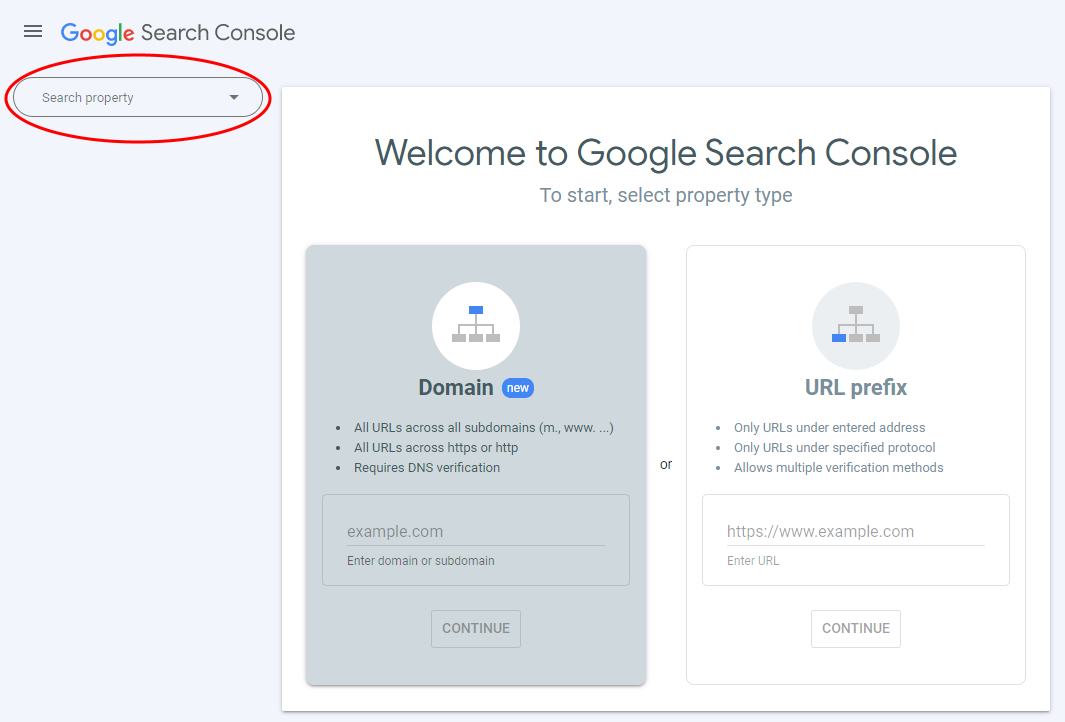 Screenshot from Google Search Console, August 2022
Screenshot from Google Search Console, August 2022Then, in the sidebar on the left, click on Security & Manual Actions and choose Manual actions.
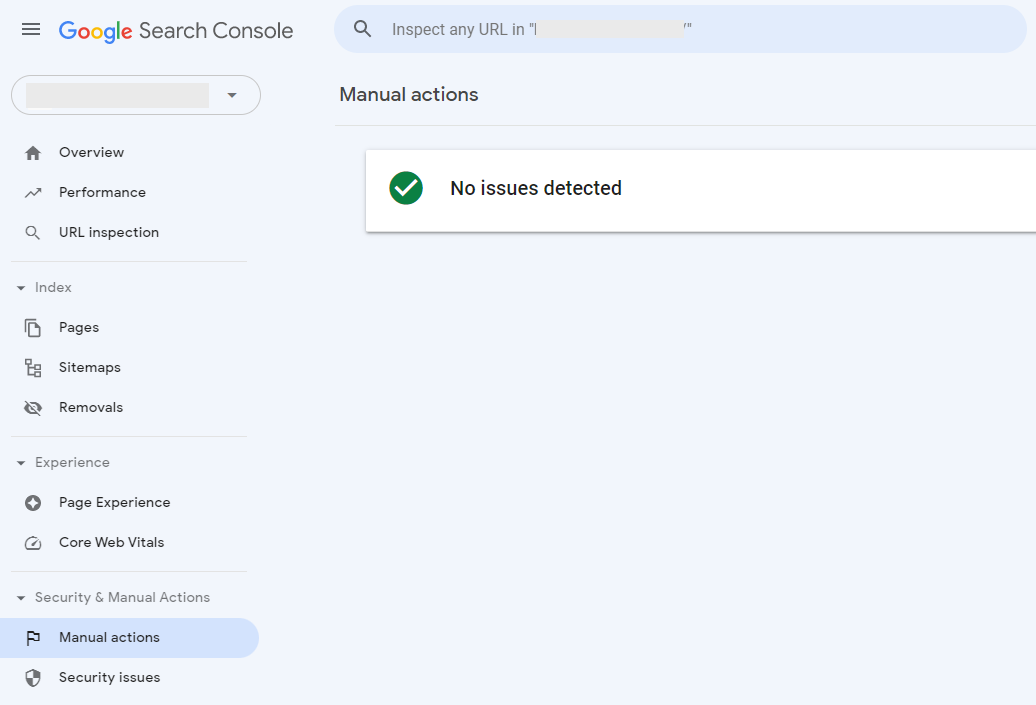 Screenshot from Google Search Console, August 2022
Screenshot from Google Search Console, August 2022If it says, “No issues detected,” great!
If it says anything else, there’s your first batch of problems to fix.
2. Run A Keyword Audit
This is your first exciting dip into uncovering hidden opportunities with local SEO. There’s a lot you can discover and improve within this step!
For this step, you will need a list of keywords that you are trying to rank for.
You can probably deduce some of those keywords on your own.
For example, if you own a bakery shop in London, that’s already one relevant keyword candidate – “bakery shops in London”.
Once you have discovered your keywords, check them for two things:
- Your current ranking with the keywords.
- User search intent.
Let’s start with discovering keyword rankings.
How To Discover Keyword Rankings
First, you need to find out if your website appears on a search engine results page (SERP) at all. Your ultimate goal is to appear either on page 1 or in the 3-Pack.
You can try Googling the keywords from your keyword list one by one, but it will be faster to use an SEO tool and check them all at once.
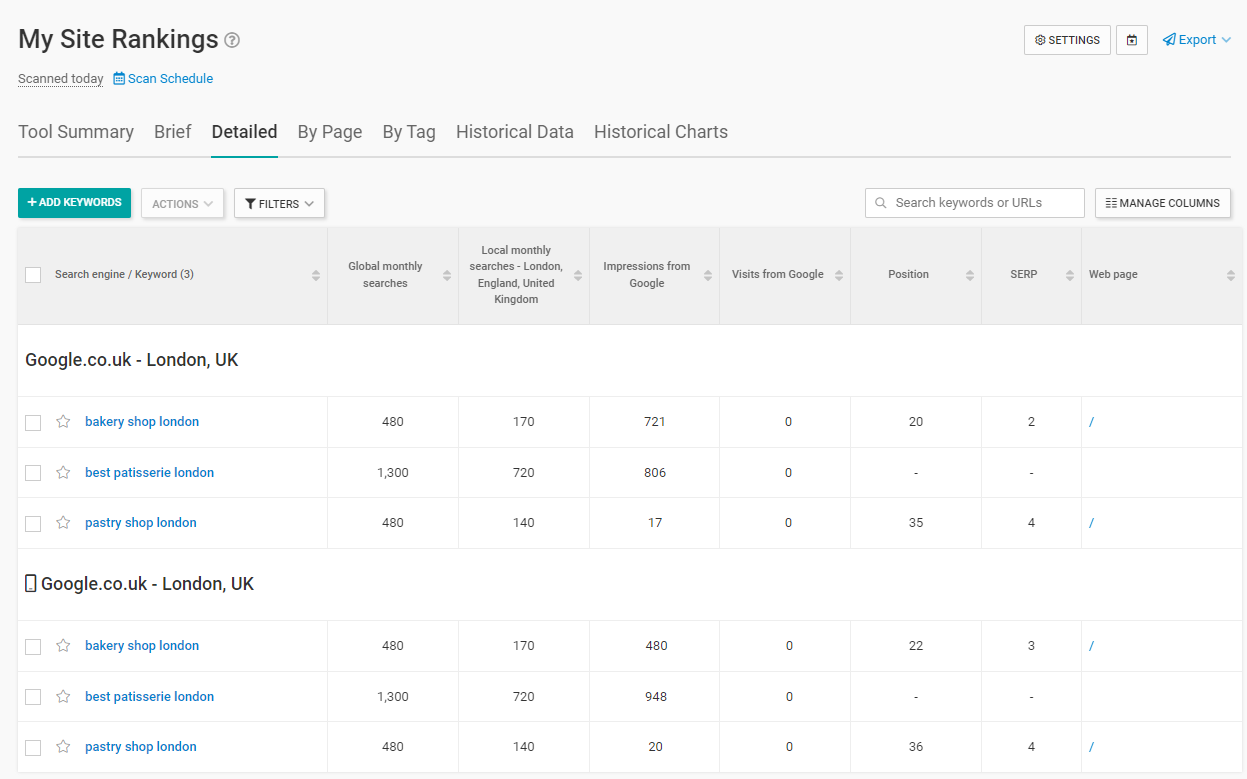 Screenshot from WebCEO.com, August 2022
Screenshot from WebCEO.com, August 2022Simply scan your site rankings in WebCEO’s Rank Tracking tool.
- Click on +Add Keywords.
- Type in all the keywords you want to check.
- Press Save and Scan to generate a report.
This tool’s settings allow for scanning in specified locations, which is just what we need for local SEO.
It can even detect more interesting search results like the local pack, hotels, or Knowledge Panel.
Once you receive the report, look at the columns Position and SERP; they show where your site is ranking.
It also doesn’t hurt to check the Local monthly searches column, as it shows how often users type those keywords into Google.
If any of these columns aren’t in the report, press the Manage columns button to add them.
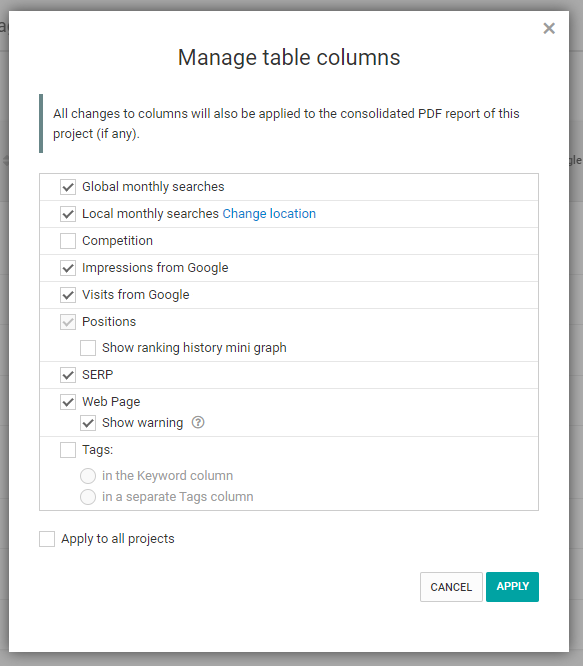 Screenshot from WebCEO.com, August 2022
Screenshot from WebCEO.com, August 2022Now, let’s analyze your keywords for user search intent.
How To Discover Keyword Search Intent
Search intent boils down to understanding what potential shoppers type into Google to get different results that match what they want.
For instance, a shopper might type in “buy blue iced baby boy sugar cookies in London” – this type of search has a “Transactional” intent. You want to make sure your keywords leverage transactional or commercial intent.
So, ask yourself these questions:
- Are you using any keywords which are irrelevant to the site or provided services?
- Are your selected keywords short-tail or long-tail keywords? Long-tailed ones tend to be more specific, and therefore more effective. It’s very hard to rank for a short-tailed keyword if you aren’t a big shot.
- Do the keywords include words like where, closest, near me? Location-based searches often use words like that, so it’s a common local SEO practice to use them in your keywords too.
Now that you understand your position within keyword searches and the intent behind those keywords, you now have the information you need to modify your content strategy to boost your website’s rankings.
3. Check Your Google Business Profile
To begin with, do you or your customer have a Google Business Profile (GBP) listing?
If not, that’s really bad news for your local SEO. Fixing this is a really quick win for local search efforts, making it a great hidden opportunity!
If you do, log into the Google Business Profile and discover:
Is Any Information Missing From Your Google Business Profile?
A blank field in GBP is a hole in your local SEO. All fields should be filled out with accurate, up-to-date information about the business:
- Name.
- Description.
- Categories.
- Address.
- Opening hours, and so on.
Mind the character limits, too.
Are Keywords Present & Used Properly On Your Google Business Profile?
Keywords (especially local ones) in your GBP are a major ranking factor.
They can ensure your business will appear in Google’s very competitive local pack.
The catch is, you can’t just put them in the title and call it a day: that goes against Google’s guidelines, which demand using the business’ real-world name.
However, craftier owners simply include keywords when naming their businesses. It’s a perfectly valid loophole that satisfies both the guidelines and the ranking algorithm.
The only thing to worry about is making the name sound natural.
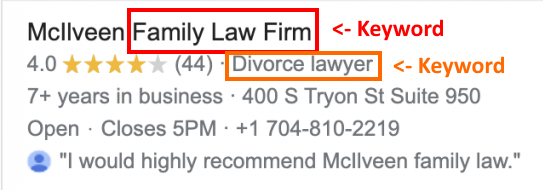 Screenshot from Google, August 2022
Screenshot from Google, August 2022Relevant keywords should also be included in the GBP categories. Putting them in the description is optional, although encouraged.
Are Photos & Other Images Uploaded On Your GBP?
There are a variety of images you can upload to your Google Business Profile. The more you have, the better.
- Logo: Every business needs one.
- Cover photo: Obligatory. Google displays it in search results.
- Exterior photos: Customers will easily find you if they know what the place looks like.
- Interior photos: First-time visitors will be more at ease if they know beforehand what’s inside.
- Team photos: Another comfort factor. Bonus points if you have reviews praising individual employees – photos can turn them into local celebrities.
- Product/service photos: Customers need to know what to expect.
It goes without saying that all images should be of high quality.
Videos, too, deserve a mention as another type of visual. If there are any, watch them, and see if you can find any problems.
What Is The Posting Activity Like?
GBP allows you to create posts in order to communicate with your target audience. Take a look at the posting activity on the page.
Posting once a month is considered the bare minimum, so ask yourself these questions:
- How often does the GBP owner post?
- What kind of content is posted?
- Do they engage with customers?
- Do they promote events and sales?
Frequent and diverse posts can ensure this feature is used efficiently. It’s also good for posts to contain links, photos, and geo-mentions.
Is There An FAQ Page?
An FAQ is a powerful asset for any website, and customers are guaranteed to have questions.
4. Find On-Page SEO Issues
On-page optimization is incredibly important, making it a great hidden opportunity – especially if your competition isn’t doing this.
We admit it can be a lot of work, and there’s also plenty of room for mistakes, but if you get them all right, you’ll come out on top!
Waste no time dealing with problems. Find them all in WebCEO’s On-Site Issues Overview report.
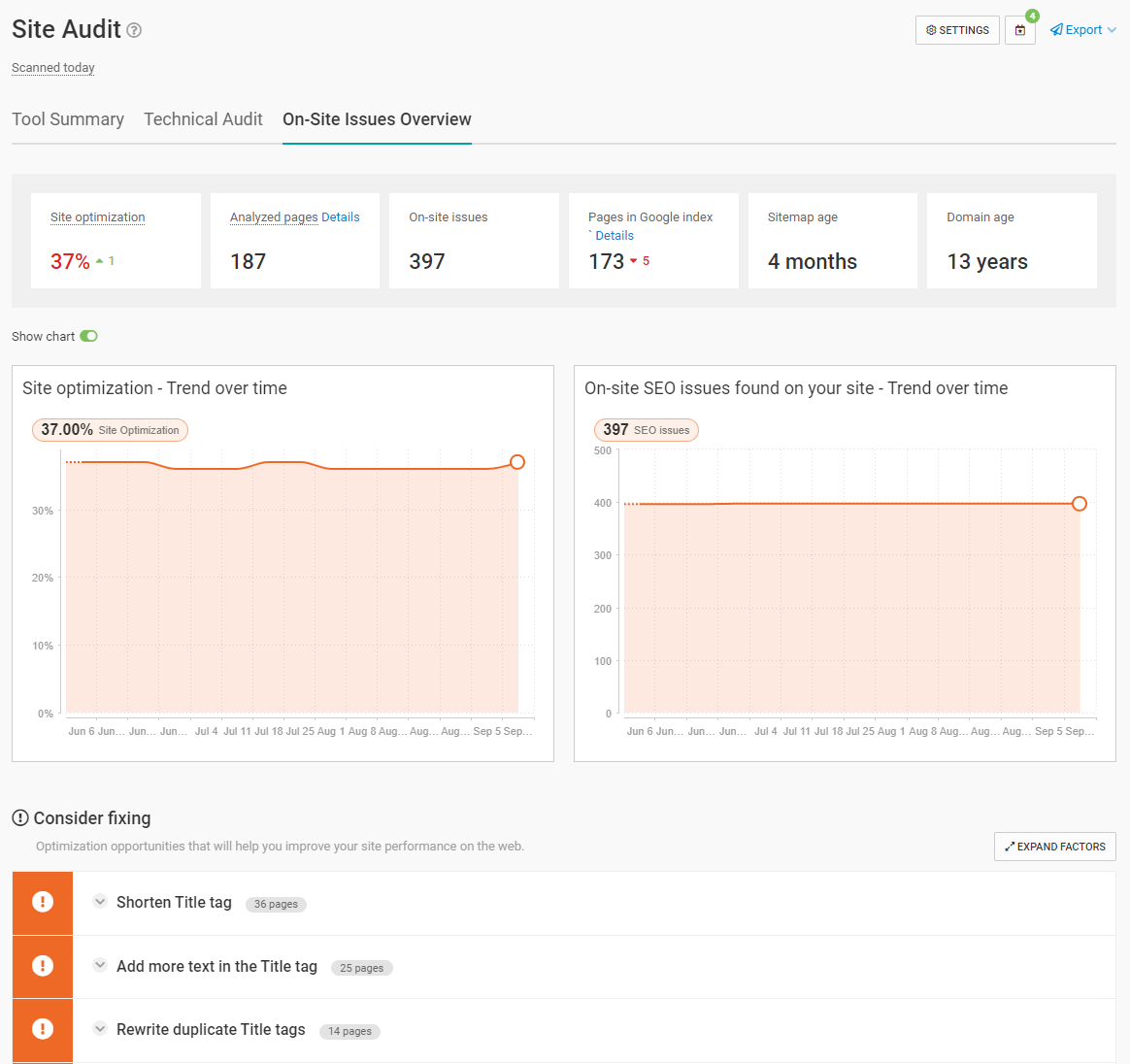 Screenshot from WebCEO.com, August 2022
Screenshot from WebCEO.com, August 2022This tool will scan all site pages at once, so you’ll be able to catch every on-page SEO error.
For a local SEO audit, here are the most important issues to keep an eye on:
- Broken images.
- A missing sitemap.
- A missing robots.txt file.
- Missing ALT attributes for images.
- Overly long, missing, or duplicate title and description tags.
Naturally, any other issues displayed in the report should not be ignored. They all negatively affect site rankings.
5. Perform A Backlink Audit
Backlinks are the most powerful ranking factor of all, making it a, you guessed it, hidden opportunity to rank higher than your competition.
Backlinks can make or break your SEO, even when you’ve done everything else right. No SEO audit is complete without a backlink analysis, and local SEO is no exception.
So make haste. Scan your link profile with WebCEO’s Backlink Checker.
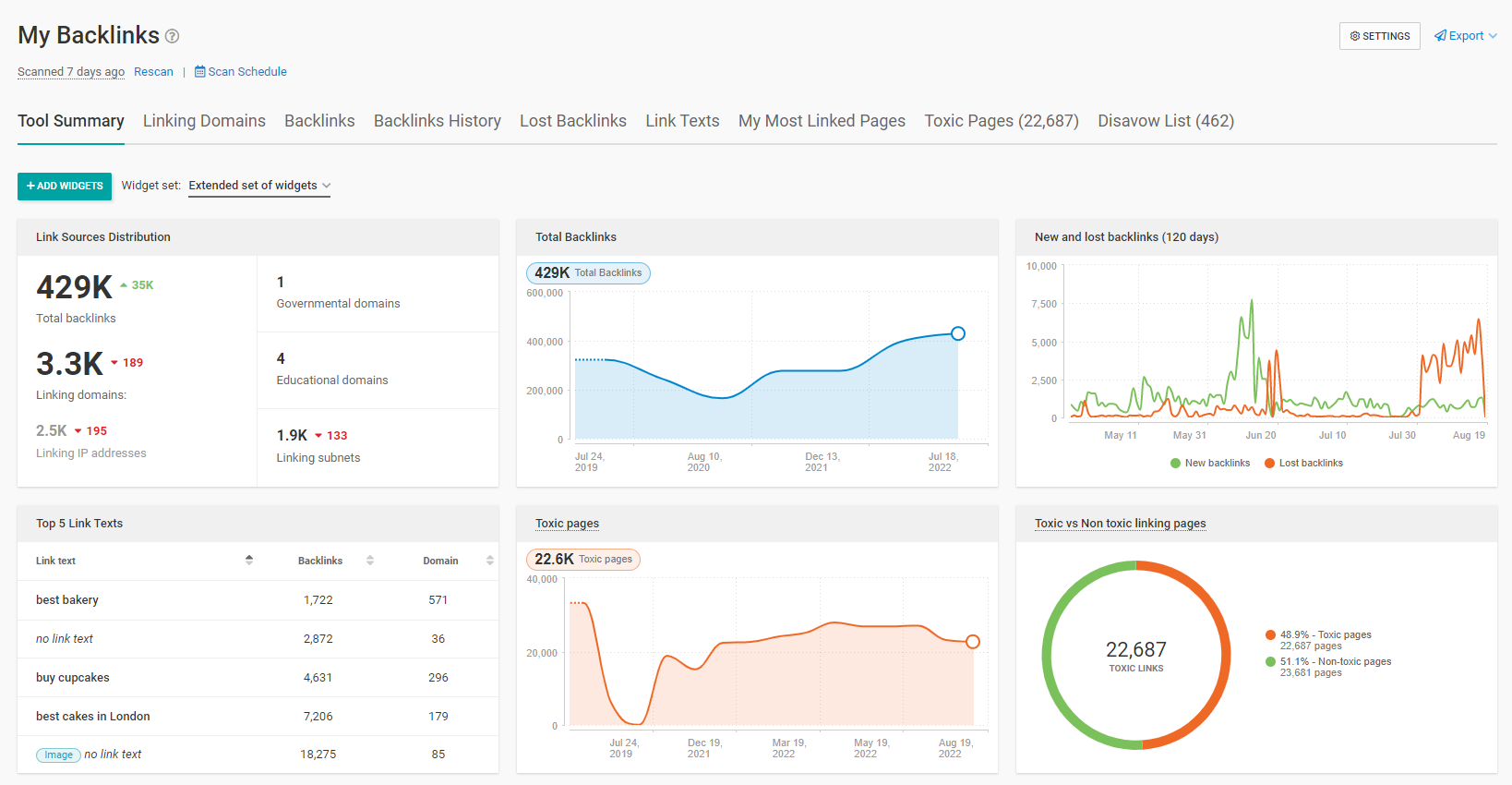 Screenshot from WebCEO.com, August 2022
Screenshot from WebCEO.com, August 2022Once your report is ready, it’s time to appraise your backlink profile.
- Are you gaining or losing backlinks? Of course, quality trumps quantity, but a stable trend of losing backlinks is a bad sign.
- Are you collecting backlinks from domains that are relevant to your niche? These are the best kind of backlinks to increase your site rankings and authority.
- Are you collecting spammy backlinks from undesirable pages or domains? If yes, it will be necessary to get rid of them – either by having them removed or by disavowing them.
- What are the most common anchor texts in your backlinks? Anchor texts act as your ranking keywords, so your ideal scenario is lots of anchors which match your preferred keywords. Textless anchors also count as anchors but are less than ideal.
Based on this analysis, you will be able to fix the flaws in your customer’s link building strategy.
6. Evaluate Your Online Reputation
A local business lives or dies by its reputation among customers. Good thing we have the internet, right? There’s no place like it to find out what people think about you, and lose all sleep over it.
Hopefully, your customers will keep sleeping well after you are done with this step. What should you check for?
Collect Reviews For Your Website & Potential Keywords
Any self-respecting local business should be collecting customer reviews on its website. Positive and negative reviews, detailed feedback – be sure to pay attention to everything. A review is especially valuable when it has keywords your site ranks for.
Google Business Profile’s review section is another place you can’t overlook. And if your client has created listings for their business on any review platforms, be sure to check there as well.
Be Sure Ratings Are Included In Your Reviews
Where there are reviews, there are usually star ratings on the same page, too. In fact, paired, they are very beneficial for SEO.
But it’s also common for business directories to display rating scores separately from user reviews.
If your client’s website appears in Google’s local pack, that’s the fastest way to see your client’s ratings. Of course, a thorough local SEO audit will require more information from other places.
Get Notified When Your Brand Is Mentioned
Everybody wants their brand to be the talk of the town. Problem is, there’s only so much you can hear with your own ears and so much self-Googling you can do on your own.
Thankfully, there are tools for picking up the word on the e-streets.
Who, where, what, and when – find all your online mentions with WebCEO’s Web Buzz Monitoring tool. Just add the keywords related to the local business whose SEO you are auditing (its name will do best). The tool will show you the sites and the tweets where it has been brought up.
Improve Social Media Engagement
If your client has created social media pages for their business (as anyone should), you need to have a look at them, too.
How do you know if they are well run? Pass your judgment by answering these questions:
- How often do they post new updates?
- What is the format of the updates? Text, images, videos, polls, or other?
- How much user engagement (likes, shares, upvotes, comments, etc.) do they get?
- How do the users respond to the updates in the comment section?
- How quickly does your client respond to the users?
As a rule of thumb, lots of activity (from the owner and users) on a social media page is good. If you find any problems there, jot them down.
7 – 15. Download The Free Local SEO Guide
Would you like even more expert tips for a DIY local SEO audit?
Download your local SEO guide below. With this and pro-level SEO tools at your fingertips, you’ll be able to evaluate the state of any website’s local SEO – be it yours or your customer’s.
This guide was created exclusively for WebCEO users. Sign up now to enter the world of experts!
The opinions expressed in this article are the sponsor's own.



